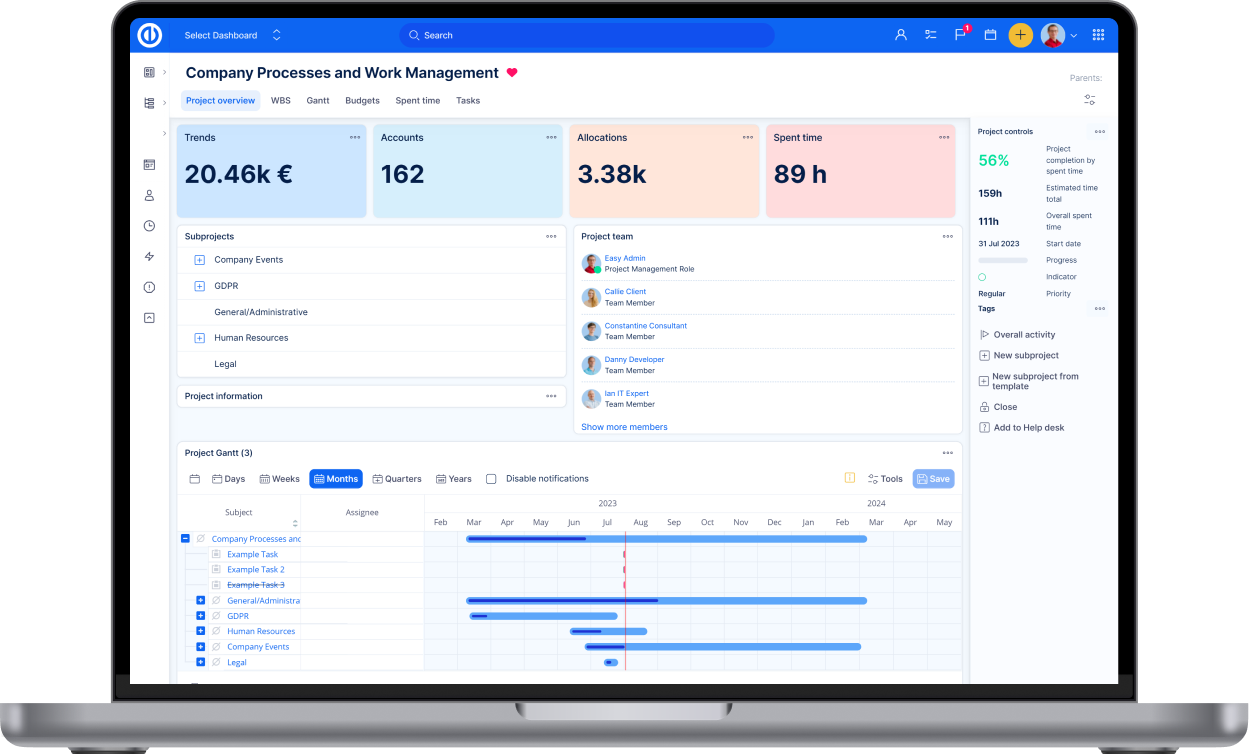Jira vs. Easy Redmine: Comparison of project management software
Still not sure if Jira is the right fit for your projects? Read this comparison to discover why more and more teams are switching to Easy Redmine—and why it could save you time, money and frustration.

Table of contents
Common and significant issues with Jira
Why Jira vs. Redmine battle matters for your project success
Jira vs. Easy Redmine: Waterfall project management
Jira vs. Easy Redmine: Agile project management
Jira vs. Easy Redmine: Business processes
Jira vs. Easy Redmine: Integrations and automation
Jira vs. Easy Redmine: ITSM & helpdesk
Jira vs. Easy Redmine: On-premises
Jira vs. Easy Redmine: Security & governance
Jira vs. Easy Redmine: Pricing
How to switch from Jira to Easy Redmine
Why is Easy Redmine better than Jira
TL;DR
Easy Redmine offers a more cost-effective, all-in-one, open-source project management solution—with native Waterfall and Agile tools, ITSM capabilities, on-premises support starting at just 25 users, built-in integrations, and robust security—compared to Jira’s steeper pricing, reliance on plugins or separate tools, and higher minimums for self-hosting.
Common and significant issues with Jira
Before you commit to Jira, it’s worth understanding the common issues many teams face when using it. Jira may be powerful, but there is:
- Complexity and learning curve: Jira is often criticized for its complexity in administration and configuration, leading to a steep learning curve and time wasted on setup instead of development.
- Customization challenges: Jira's flexibility supports various workflows, but can result in unmanageable custom setups and user frustration due to client-imposed restrictions on customization.
- Usability and user experience: Jira's UX is often seen as clunky, with its feature-rich but unintuitive interface, excessive required fields, and rigidity making simple tasks overly complex compared to tools like Trello or GitHub.
- Performance and reliability: Some users have reported that Jira can be slow and unreliable, particularly when using cloud-hosted solutions. These performance bottlenecks can hinder productivity and frustrate users who rely on the tool for daily operations.
Why Jira vs. Redmine battle matters for your project success
Are you torn between Jira vs Redmine for your next project management solution? You're not alone. The wrong choice could mean wasted resources, frustrated team members, and missed deadlines.
Jira vs. Easy Redmine: Waterfall project management
If your team relies on traditional project management methodologies, Easy Redmine provides superior out-of-the-box functionality.
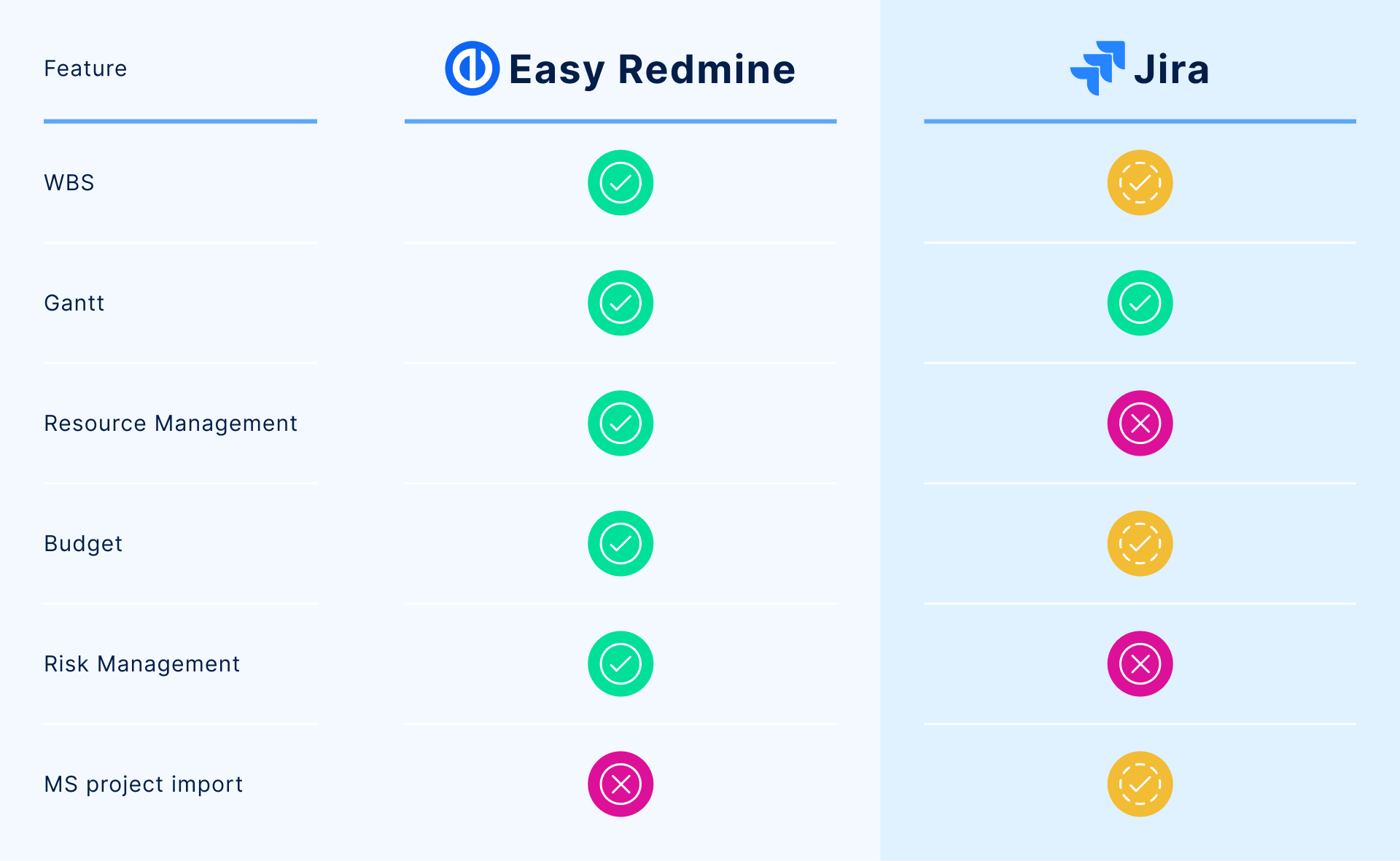
Jira vs. Easy Redmine: Agile project management
While Jira is popular for Agile, Easy Redmine combines Agile and classic project tools in a single interface tailored for project managers who need flexibility.
Anyway, analyse it using the overview in the table:
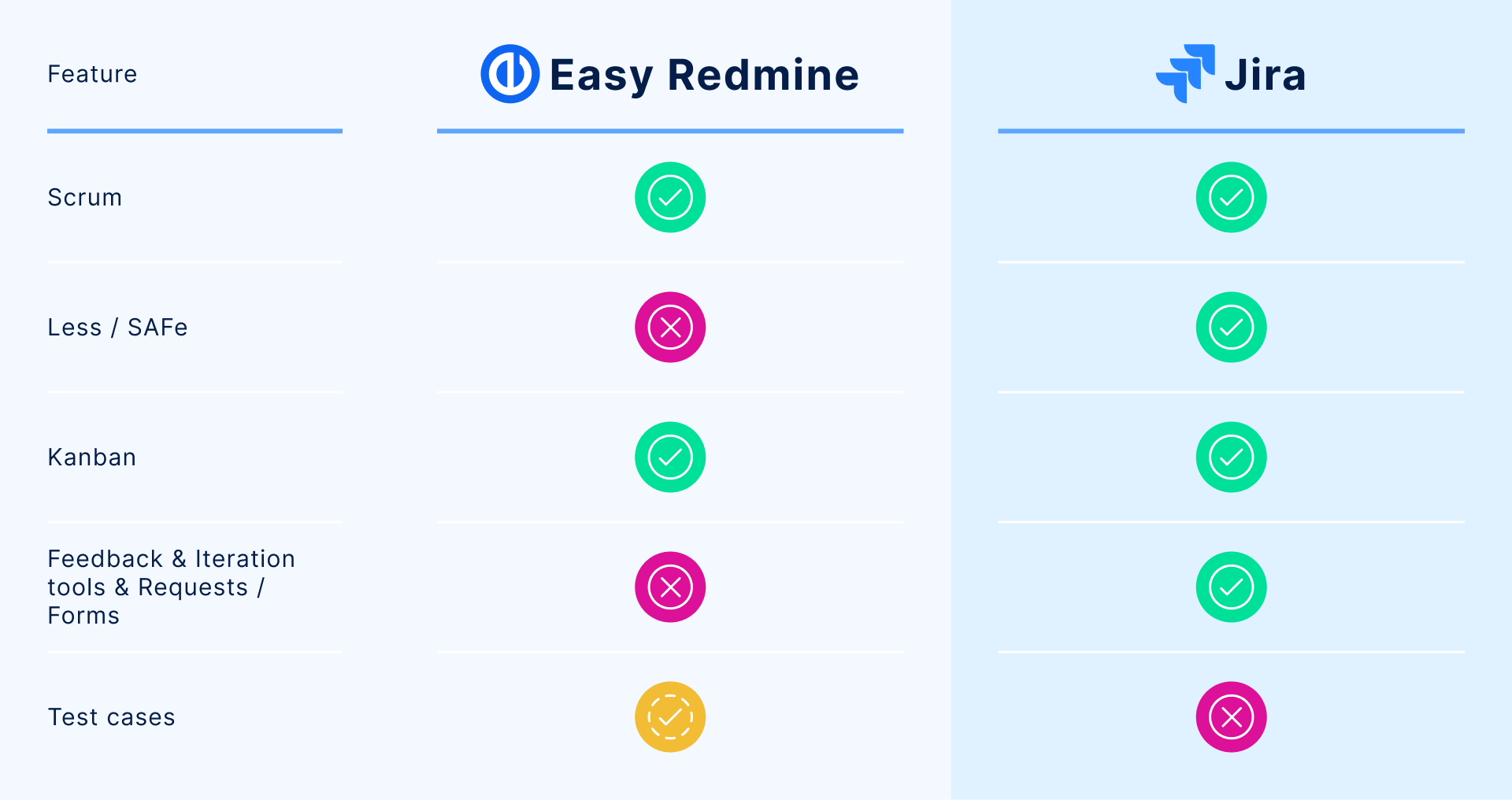
Jira vs. Easy Redmine: Business processes
Obviously, Easy Redmine covers more business process needs out of the box, offering extras like Attendance tracking, Time sheets and Template creation, which are either limited or missing in Jira.
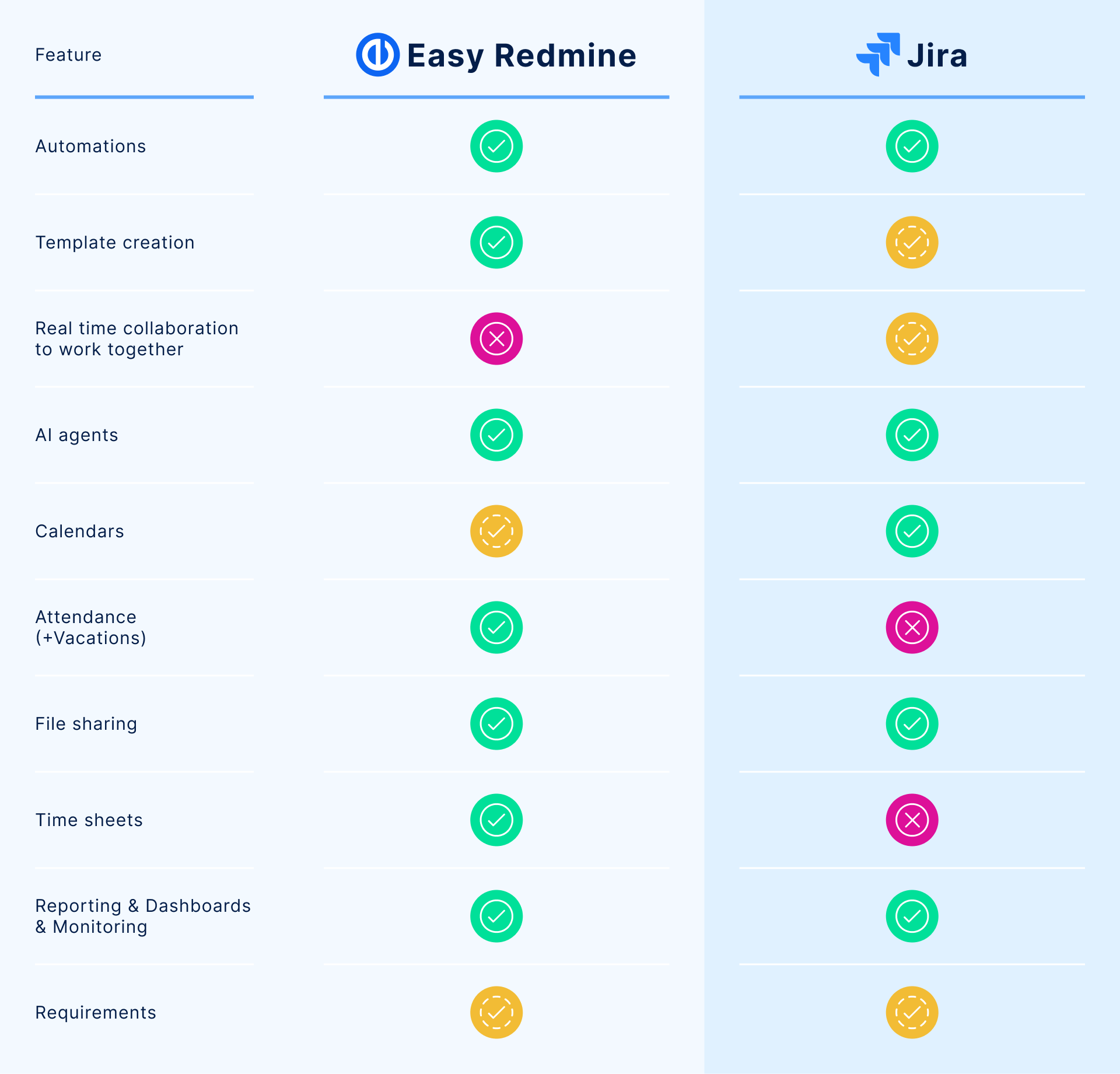
Jira vs. Easy Redmine: Integrations and automation
Both Easy Redmine and Jira support key automation platforms like Zapier, Make.com and n8n.io, but Easy Redmine goes further with a built-in Jira integration for smoother tool switching.
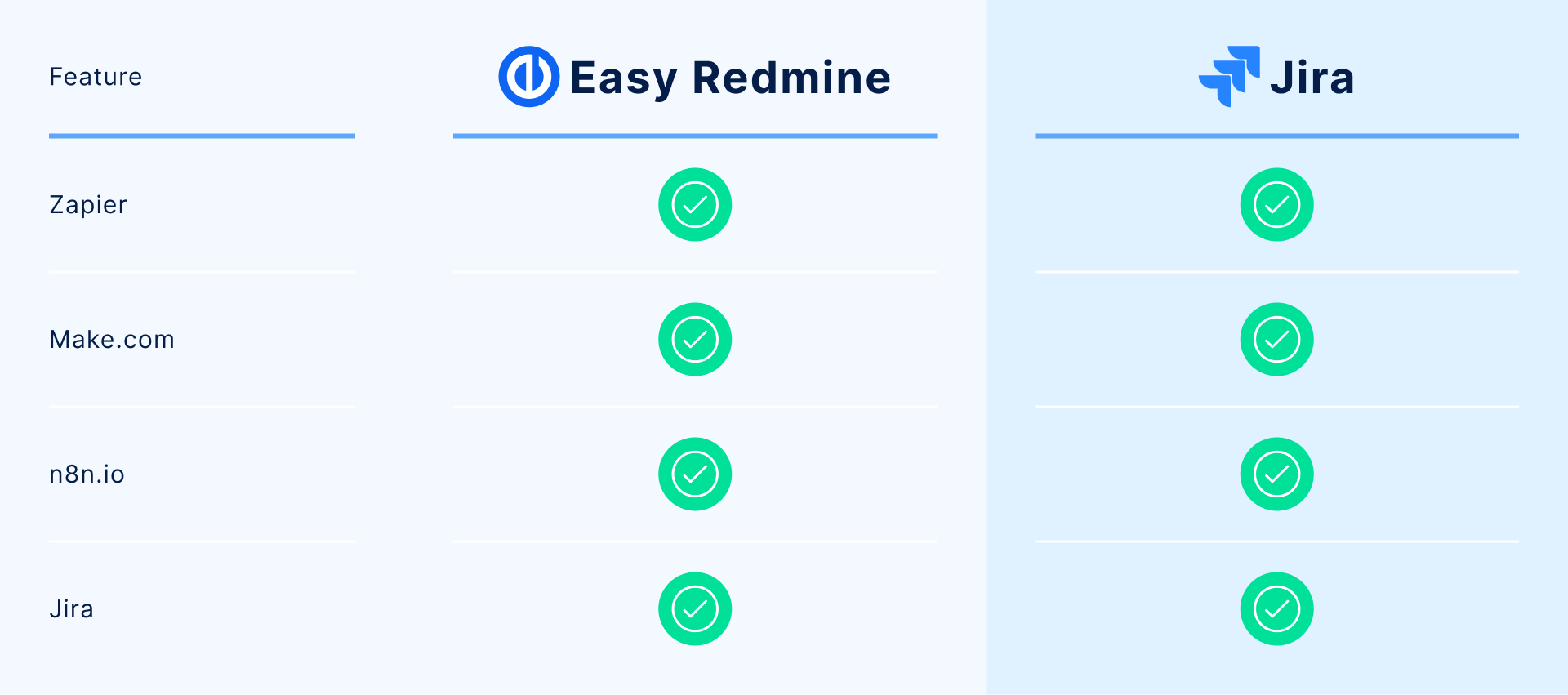
Jira vs. Easy Redmine: ITSM & helpdesk
When it comes to IT Service Management, both Jira and Easy Redmine offer solid capabilities, but with key differences. Easy Redmine is giving project managers a ready-to-use ITSM toolbox that includes built-in:
- HelpDesk (alternative to Service Desk)
- Knowledge management (by Knowledge Base)
- Assets & Configuration management
Jira matches these features through Jira Service Management and Confluence, but often requires additional setup or plugins. Neither platform covers Inventory or Warehouse management natively, so third-party solutions may be necessary for that.
Jira vs. Easy Redmine: On-premises
The future of on-premises Jira is uncertain, as Atlassian ended Server support in February 2024, meaning users will no longer receive essential updates or security patches. Atlassian's alternative, Jira Data Center, is not a perpetual server installation but a subscription model requiring annual payments, and it becomes unusable if the license lapses.
This poses significant challenges, especially for companies with fewer than 500 users, and industries with regulatory requirements to host data on-premises are particularly affected, as they are forced to purchase more licenses than needed for Jira Data Center.
On the other hand, Easy Redmine on-premises is a great choice for organisations that require full data control, enhanced privacy, and the ability to customise their project environment to specific internal policies and infrastructure.
Jira vs. Easy Redmine: Security & governance
In terms of security and governance, both Easy Redmine and Jira meet GDPR compliance.
Easy Redmine stands out with its open-source core and detailed security architecture including encrypted backups, two-factor authentication, role-based permissions, and ISO 27001 compliant hosting.
Jira, while not open-source, offers strong governance through certifications like SOC 2 and ISO 27001, and integrates deeply with Atlassian’s ecosystem for compliance and auditing.
For organisations valuing transparency and control, Easy Redmine provides more flexibility, especially with its open-source nature and customisable security layers.
Jira vs. Easy Redmine: Pricing
Taking a closer look at pricing, there are these 3 conclusions:
- Small company (50 users): Easy Redmine’s Essentials ($ 7.50 per user/month) is similar to Jira Standard ($ 7.16 per user/month)
- Mid-market (150 users): Easy Redmine’s Business ($ 14.90 per user/month) is roughly 10.5% cheaper than Jira Premium ($ 16.66 per user/month).
- Enterprise scale (500+ users): Both solutions require direct sales consultation at this level, with Easy Redmine Business/Platform and Jira Enterprise plan offering customised pricing based on your specific business requirements and implementation needs.
- On-premises: Easy Redmine self-hosted starts at just 25 users ($ 7.50 per user/month), whereas Jira Data Center requires a 500-user minimum and carries a significantly higher annual license fee.
Overall, Easy Redmine delivers comparable feature coverage at a lower cost, depending on the enterprise's requirements.
How to switch from Jira to Easy Redmine
Already decided to switch from Jira to Easy Redmine? It is simple with a clear migration process, professional support, and advanced import tools for Jira. Find out more in this article.
Easy Software ensures a smooth transition through pre-configuration, user training, and data verification—whether you're moving to cloud or on-premises, both offer the same feature set.
Still hesitating? Read the project management case study of Aspecta and see how the migration from Jira to Easy Redmine was carried out.
Why is Easy Redmine better than Jira
The Jira vs. Redmine debate ultimately comes down to your team's specific needs. Both platforms offer robust project management capabilities, but they serve different project management philosophies.
Easy Redmine stands as the top open-source Jira alternative, that delivers true hybrid project management—seamlessly combining Waterfall and Agile methodologies—alongside a built-in Knowledge Base (remember Jira's Confluence?), HelpDesk (alternative to Jira's Service Desk), AI integrations and data-driven AI agents, all within an open-source Jira alternative.
Easy Redmine also offers on-premises deployment starting at just 25 users and far more affordable pricing, whereas Jira’s self-hosted option kicks in at 500+ users with a significantly higher cost.
Book an Easy Redmine demo or start a free trial of Easy Redmine project management software to see how it can transform your technology projects with Agile & Waterfall project management, HelpDesk and software development.



